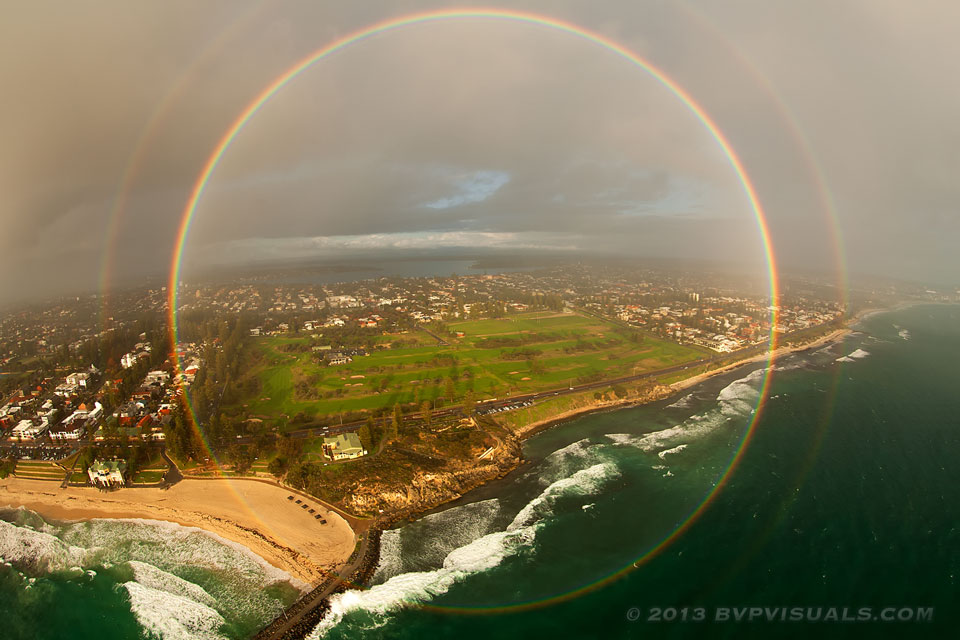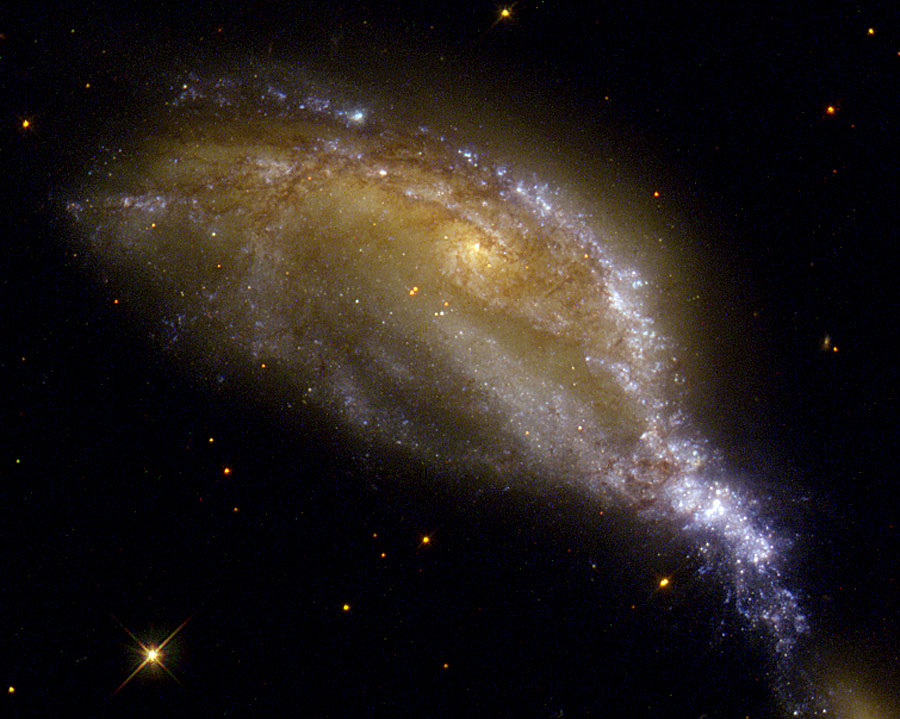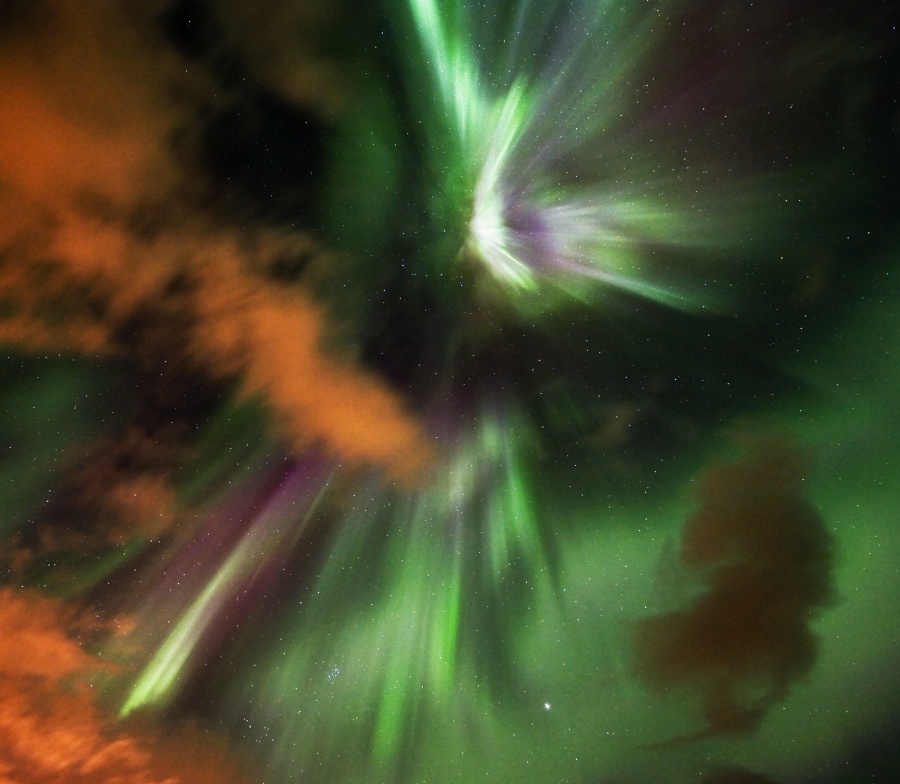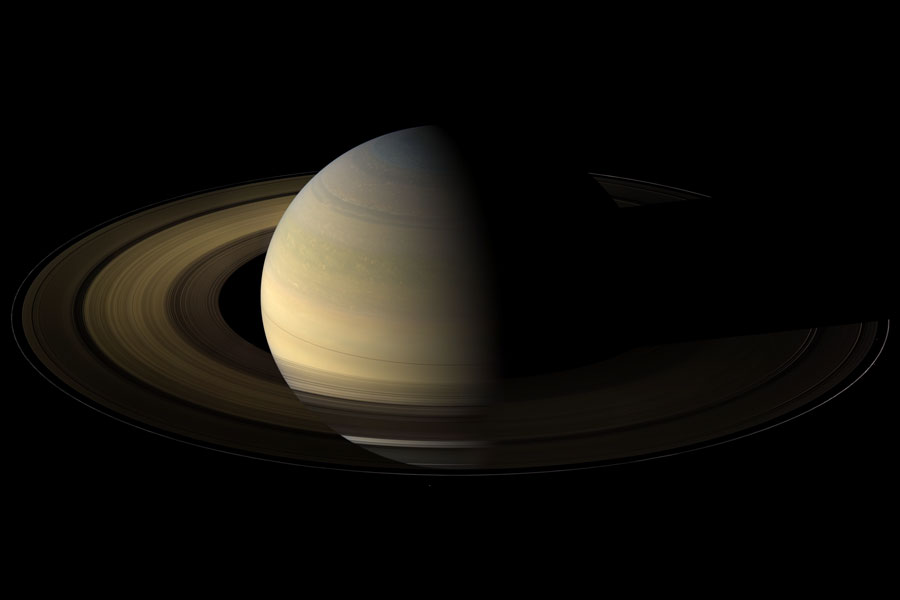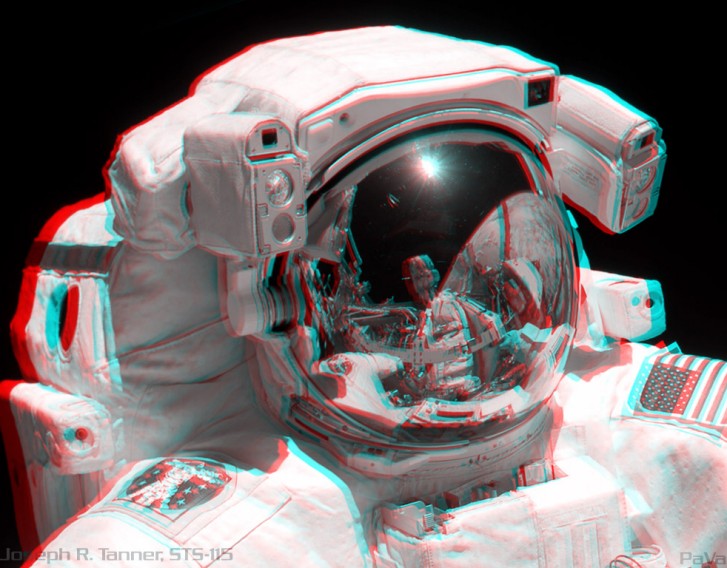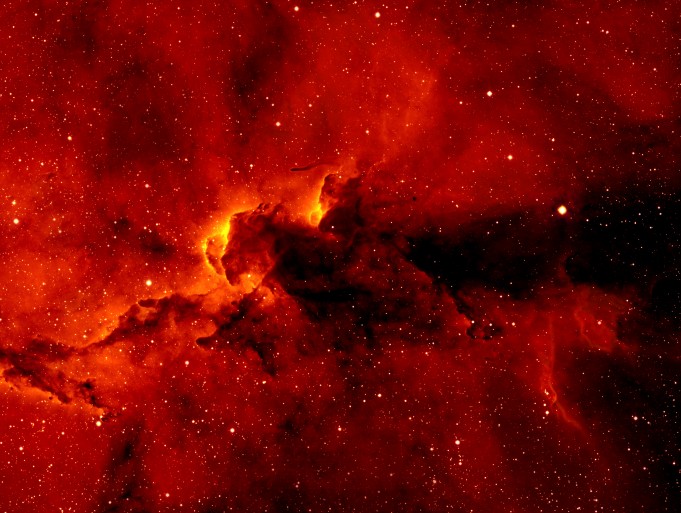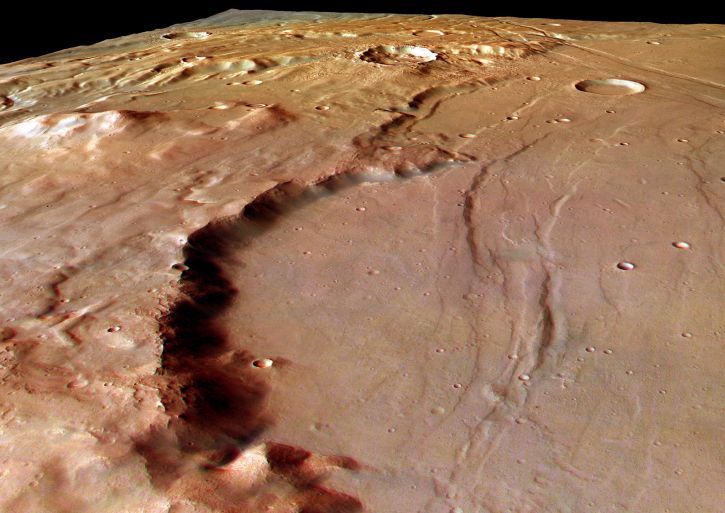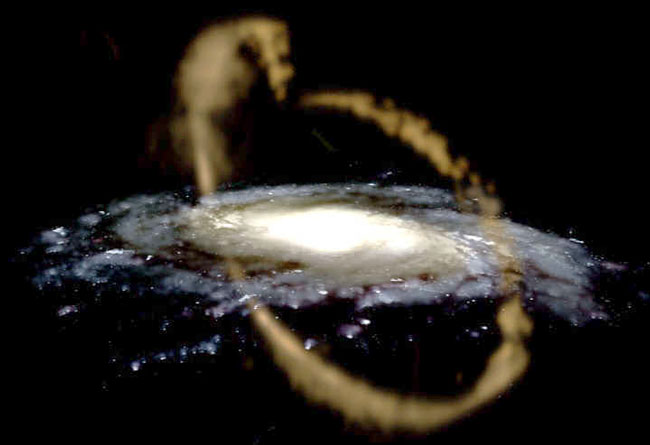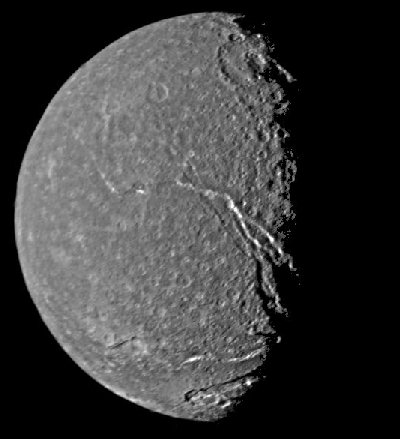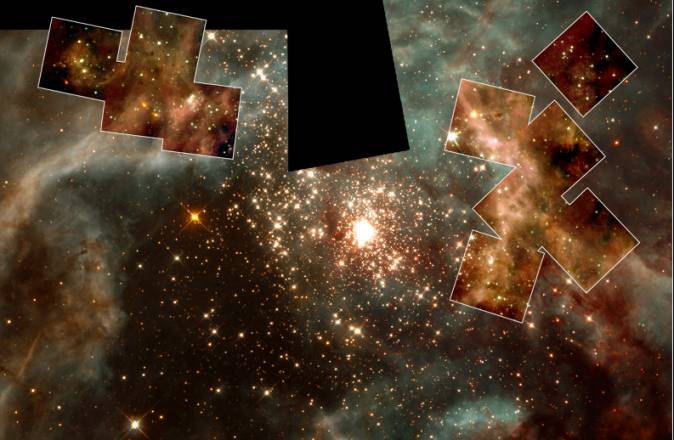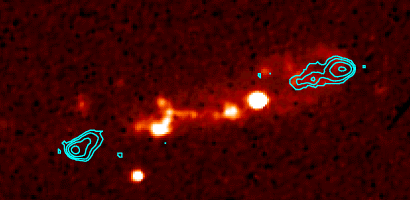[table][tr][td=left]<< Previous[/td][td=center]Index[/td][td=right]Next >>[/td][/tr][/table][/b]
2014 Have you ever seen an entire rainbow? From the ground, typically, only the top portion of a rainbow is visible because directions toward the ground have fewer raindrops. From the air, though, the entire 360 degree circle of a rainbow is more commonly visible. Pictured here, a full circle rainbow was captured over Cottesloe Beach near Perth, Australia last year by a helicopter flying between a setting sun and a downpour. An observer-dependent phenomenon primarily caused by the internal reflection of sunlight by raindrops, the 84-degree diameter rainbow followed the helicopter, intact, for about 5 kilometers. As a bonus, a second rainbow that was more faint and color-reversed was visible outside the first.
2013
Click to play embedded YouTube video.
Video Credit & Copyright: Kevin Snair, Creative Imagery
2012
2011 On September 26, a large solar coronal mass ejection smacked into planet Earth's magnetosphere producing a severe geomagnetic storm and wide spread auroras. Captured here near local midnight from Kvaløya island outside Tromsø in northern Norway, the intense auroral glow was framed by parting rain clouds. Tinted orange, the clouds are also in silhouette as the tops of the colorful shimmering curtains of northern lights extend well over 100 kilometers above the ground. Though the auroral rays are parallel, perspective makes them appear to radiate from a vanishing point at the zenith. Near the bottom of the scene, an even more distant Pleiades star cluster and bright planet Jupiter shine on this cloudy northern night.
2010
2009 How would Saturn look if its ring plane pointed right at the Sun? Before last month, nobody knew. Every 15 years, as seen from Earth, Saturn's rings point toward the Earth and appear to disappear. The disappearing rings are no longer a mystery -- Saturn's rings are known to be so thin and the Earth is so near the Sun that when the rings point toward the Sun, they also point nearly edge-on at the Earth. Fortunately, in this third millennium, humanity is advanced enough to have a spacecraft that can see the rings during equinox from the side. Last month, that Saturn-orbiting spacecraft, Cassini, was able to snap a series of unprecedented pictures of Saturn's rings during equinox. A digital composite of 75 such images is shown above. The rings appear unusually dark, and a very thin ring shadow line can be made out on Saturn's cloud-tops. Objects sticking out of the ring plane are brightly illuminated and cast long shadows. Inspection of these images may help humanity understand the specific sizes of Saturn's ring particles and the general dynamics of orbital motion.
2008 Can you spot the Solar System's four rocky planets? In the above image taken on September 20, all of them were visible in a single glance, but some of them may be different than you think. Pictured above, the brightest and highest object in the sky is the planet Venus. The object lowest in the sky is the planet Mars, while the object furthest to the left is the planet Mercury. The last remaining point of light is . . . the bright star Spica, which leaves the question -- where is the fourth rocky planet? That would be Earth, specifically part of Australia, visible across the entire bottom of the image.
2007 Most bright stars in our Milky Way Galaxy reside in a disk. Since our Sun also resides in this disk, these stars appear to us as a diffuse band that circles the sky. The above panorama of a northern band of the Milky Way's disk covers 90 degrees and is a digitally created mosaic of several independent exposures. Scrolling right will display the rest of this spectacular picture. Visible are many bright stars, dark dust lanes, red emission nebulae, blue reflection nebulae, and clusters of stars. In addition to all this matter that we can see, astronomers suspect there exists even more dark matter that we cannot see.
2006 On September 12, astronaut Heidemarie Stefanyshyn-Piper snapped photos of her colleague Joseph Tanner during the STS-115 mission. At the time, the spacesuited pair were working outside the shuttle orbiter Atlantis, some 300 kilometers above planet Earth. Portions of two of the pictures (S115-E-05750 and S115-E-05753) have been combined in this spectacular 3D image - a stereo anaglyph intended to be viewed with red/blue glasses. Included in the scene reflected in Tanner's visor is Stefanyshyn-Piper herself and the Sun shining above the Earth's distant horizon.
2005 Clouds of glowing hydrogen gas mingle ominously with dark dust lanes in this close-up of IC 1396, an active star forming region some 2,000 light years away in the constellation Cepheus. In this and other similar emission nebulae, energetic ultraviolet light from a hot young star strips electrons from the surrounding hydrogen atoms. As the electrons and atoms recombine they emit longer wavelength, lower energy light in a well known characteristic pattern of bright spectral lines. At visible wavelengths, the strongest emission line in this pattern is in the red part of the spectrum and is known as "Hydrogen-alpha" or just H-alpha. Part of IPHAS, a survey of H-alpha emission in our Milky Way Galaxy, this image spans about 20 light-years and highlights bright, dense regions within IC 1396, likely sites where massive new stars are born.
2004 This dramatic perspective view looks south-east along the wall of a large eroded impact crater on Solis Planum, bordering the mountainous Thaumasia region of Mars. Stretching for about 50 kilometers into the scene, the crater wall is around 800 meters high. Located just south and west of the Red Planet's grand Valles Marineris, this area features mountains and fault lines that are seen as evidence of surface plate motions or plate tectonics. The process of plate tectonics has long been shaping the surface of planet Earth but is thought to have been only briefly active on Mars. The image was constructed using color image data from the High Resolution Stereo Camera onboard ESA's Mars Express spacecraft.
2003 Is our Milky Way Galaxy out to lunch? Recent wide field images and analyses now indicate that our home galaxy is actually still in the process of devouring its closest satellite neighbor. This unfortunate neighbor, the Sagittarius Dwarf galaxy, is now seen to be part of a larger Sagittarius Tidal Stream, a loose filament of stars, gas, and possibly dark matter that entangles the Milky Way. An artist's depiction of the stream is shown above. Speculation also holds that the Sagittarius Dwarf was once pulled through the Milky Way disk very close to our Sun's current location. An important resulting realization is that galaxies contain a jumble of clumps and filaments of both dim and dark matter.
2002 These bacteria could survive on another planet. In an Earth lab, Deinococcus radiodurans (D. rad) survive extreme levels of radiation, extreme temperatures, dehydration, and exposure to genotoxic chemicals. Amazingly, they even have the ability to repair their own DNA, usually with 48 hours. Known as an extremophile, bacteria such as D. rad are of interest to NASA partly because they might be adaptable to help human astronauts survive on other worlds. A recent map of D. rad's DNA might allow biologists to augment their survival skills with the ability to produce medicine, clean water, and oxygen. Already they have been genetically engineered to help clean up spills of toxic mercury. Likely one of the oldest surviving life forms, D. rad was discovered by accident in the 1950s when scientists investigating food preservation techniques could not easily kill it. Pictured above, Deinococcus radiodurans grow quietly in a dish.
2001 What is creating the strange texture of IC 418? Dubbed the Spirograph Nebula for its resemblance to drawings from a cyclical drawing tool, planetary nebula IC 418 shows patterns that are not well understood. Perhaps they are related to chaotic winds from the variable central star, which changes brightness unpredictably in just a few hours. By contrast, evidence indicates that only a few million years ago, IC 418 was probably a well-understood star similar to our Sun. Only a few thousand years ago, IC 418 was probably a common red giant star. Since running out of nuclear fuel, though, the outer envelope has begun expanding outward leaving a hot remnant core destined to become a white-dwarf star, visible in the image center. The light from the central core excites surrounding atoms in the nebula causing them to glow. IC 418 lies about 2000 light-years away and spans 0.3 light-years across. This recently released false-color image taken from the Hubble Space Telescope reveals the unusual details.
2000 British astronomer Sir William Herschel discovered Titania and Oberon in January of 1787. He wasn't reading Shakespeare's A Midsummer Night's Dream though, he was making the first telescopic observations of moons of the planet Uranus (a planet which he himself discovered in 1781). In January of 1986, nearly 200 years later, NASA's robot explorer Voyager 2 became the only spacecraft to visit the remote Uranian system. Above is Voyager's highest resolution picture of Titania, Uranus' largest moon. The picture is a composite of two images recorded from a distance of 229,000 miles. The icy, rocky world is seen to be covered with impact craters. A prominent system of fault valleys, some nearly 1,000 miles long, is visible as trench-like features near the terminator (shadow line). Deposits of highly reflective material which may represent frost can be seen along the sun-facing valley walls. The large impact crater near the top, known as Gertrude, is about 180 miles across. At the bottom the 60 mile wide fault valley, Belmont Chasma, cuts into crater Ursula. Titania itself is 1,000 miles in diameter.
1999
1998 Galaxies are fascinating not only for what is visible, but for what is invisible. Grand spiral galaxy NGC 1232, recently captured in detail by the new Very Large Telescope, is a good example. The visible is dominated by millions of bright stars and dark dust, caught up in a gravitational swirl of spiral arms rotating about the center. Open clusters containing bright blue stars can be seen sprinkled along these spiral arms, while dark lanes of dense interstellar dust can be seen sprinkled between them. Less visible, but detectable, are billions of dim normal stars and vast tracts of interstellar gas, together wielding such high mass that they dominate the dynamics of the inner galaxy. Invisible are even greater amounts of matter in a form we don't yet know - pervasive dark matter needed to explain the motions of the visible in the outer galaxy. What's out there?
1997 Who ordered the Martian pizza? As Mars Pathfinder and its mobile robot Sojourner continue to explore Mars, new and interesting rocks are being discovered, even though the primary mission has been successfully completed. The rock pictured above has been dubbed "Half Dome" and was visited by Sojourner in late August. The shape and fine-scale textures of Half Dome are still being studied. As part of the extended mission, Sojourner has been sent on its longest journey yet - a 50 meter stroll around the Sagan Memorial Station.
1996 How do planets, stars, and galaxies form? How do they evolve? The International Ultraviolet Explorer (IUE) satellite was launched in 1978 and operated by NASA/ ESA/ PPARC to help provide answers to some of the most fundamental questions about the contents of our universe. IUE served as a geostationary orbiting observatory for the next 18 years acquiring over 100,000 observations with its onboard ultraviolet spectrographs. Its prodigious scientific output is only hinted at by the all-sky plot above which shows the locations of IUE's many pointed observations over its long operational history. The brightness of a point on the sky represents the the number of IUE observations. The plot is in galactic coordinates (the plane of our Galaxy runs horizontally through the middle) and reveals the positions of distant quasars, galaxies, stars, star clusters, nebulae, novae, and supernovae - testifying to IUE's broad range of capabilities. The ecliptic plane is also visible running diagonally through the center, traced out by many observations of solar system objects. After over 18 years, IUE's science operations officially end today as the final commands are transmitted to the aging satellite by controllers at NASA's Goddard Space Flight Center. Astronomers from around the world whose careers have been touched by IUE have expressed their fond farewells to this most productive and longest lived astronomical satellite and their thanks to all who have made IUE's remarkable voyage of exploration possible.
1995 The radio and optical emission seen in the above superposed images of the radio galaxy 3C368 indicate that energetic processes are at work. A radio galaxy is a galaxy that is visible to radio telescopes. A large radio signal usually indicates very powerful phenomena. The optical light is shown above in red and the radio emission in blue contours. Currently, one can only guess what causes the unusual radio and optical features. Scientists working with the Hubble Space Telescope speculate that the radio emission might have resulted from jets of high-velocity material thrown off from the center of the galaxy, while the optical light comes from gas and dust that are remnants of a burst of star formation triggered by the radio jet.
| << Previous | Index | Next >> |
